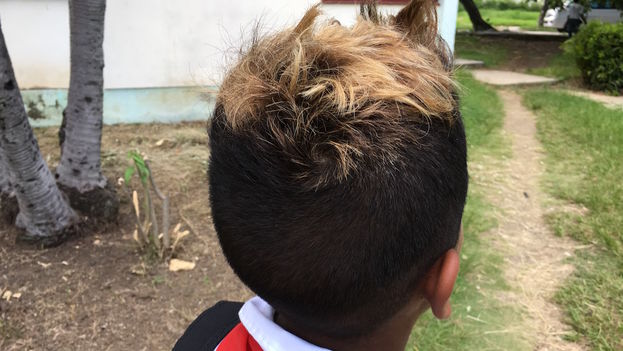
![]() 14ymedio, Luz Escobar, Havana, 8 September 2017 – The return to class, for thousands of children and young people, means a return to the discipline of school after two months of vacation. This September, school directors have focused their crusade against fingernails and hair painted bright colors, and students are forced to get haircuts or remove the enamel to conform to the regulations.
14ymedio, Luz Escobar, Havana, 8 September 2017 – The return to class, for thousands of children and young people, means a return to the discipline of school after two months of vacation. This September, school directors have focused their crusade against fingernails and hair painted bright colors, and students are forced to get haircuts or remove the enamel to conform to the regulations.
In July and August, far from the classrooms, many teenagers chose the strident tones of summer fashion. Red, green, blue and purple have been a trend in hair and phosphorescent colors are favored for fingernails, a rainbow that the schools are not willing to accept.
“I do not want to see anyone here with phosphorescent nails or hair dyed in colors,” warned a fifth-grade teacher on Monday, at the entrance of her classroom in a school in the Plaza de Revolución municipality. The scene has been repeated in schools all over the island, which stick to regulations to limit the creativity of students.
Julio Mojena, the father of twins residing in the Havana neighborhood of Cerro, considers the restrictions arbitrary since there is no written rule that specifically states them. His sons dyed their hair in August and now, he laments, “they can’t go to class until they get haircuts… In my time it was the length of the hair and the earrings, now it’s the color. What will it be tomorrow?” he asks.
“Each school can make adjustments to school regulations” depending “on the characteristics of their community,” a Ministry of Education official, who prefers to remain anonymous, told 14ymedio by phone.
Although there is no specific regulation on hair color, nails or any other detail, the official maintains that “in the schools uniformity is demanded” in the physical aspect of the student body and that this detail is supported by the general regulations.
The official acknowledges that there was a time when the length of males’ hair was strictly regulated, but that now they may “wear their mane to the collar.” Formerly males’ hair could be no more than just over an inch long.
In the eighties the crusade against hair length and the maintenance of aesthetic uniformity among students even jumped to the pages of the official newspapers. However, the José Martí Pioneer Organization (for elementary schools) and the Federation of Middle School Students did not mediate in favor of those they represent and the students did not win that symbolic battle for differentiation.
Nevertheless, controls have softened over the years, especially since the economic crisis forced families to substitute parts of the school uniform for home-made ones or to buy their children’s school shoes in the hard currency markets as a result of a breakdown in the supply of manufactured products in the ration market.
Now it is common to see students in the regulated garments modified with pleats, raised hems or adjusted sleeves.
Nor do girls and young women escape the restrictions. “In this classroom you come to study and those nails decorated with figures or painted with phosphorescent colors distract the attention of other students,” a Spanish teacher tells his students at Baragua Protest Junior High School in Central Havana.
So far this year, at least ten girls from the school say they have had problems with the manicure they were wearing when the school year began. In contrast, the pressure for them is less in terms of hair; if they dye their hair blond or red it is ignored, although other tones, such as violet, blue or green may not be.
“Reality evolves faster than school regulations,” explains Zulema Vázquez, a sociologist with two school age children. “The teaching authorities have a mentality from the last century and are not prepared to deal with the new situations that are taking place,” she says.
The specialist considers that any attempt at uniformity in terms of physical appearance eventually causes children and adolescents to find more sophisticated ways to differentiate themselves. “It can be the length of the skirt, a piercing, adjustments made to a blouse, the color or the length of the hair, but in one way or another, they will find a way to break the monotony,” argues Vázquez.
María Molina, mother of a teenager in Cienfuegos, told 14ymedio that her 14-year-old son was unable to start the school year at José Gregorio Technological Institute where he is training to be a “teacher of agriculture,” because his teacher and the school’s principal did not allow him to attend with his dyed hair.
According to Molina, the teacher and the director warned that “if you don’t cut your hair or dye it black” he would not be admitted. The mother tried to negotiate an intermediate solution and proposed that the young man cut his hair a little every week until the dyed part disappears, but her alternative was not accepted.
“As a mother I feel frustrated, I called the provincial and municipal education department and everyone repeats that we have to respect the school regulations,” she concludes with irritation.
